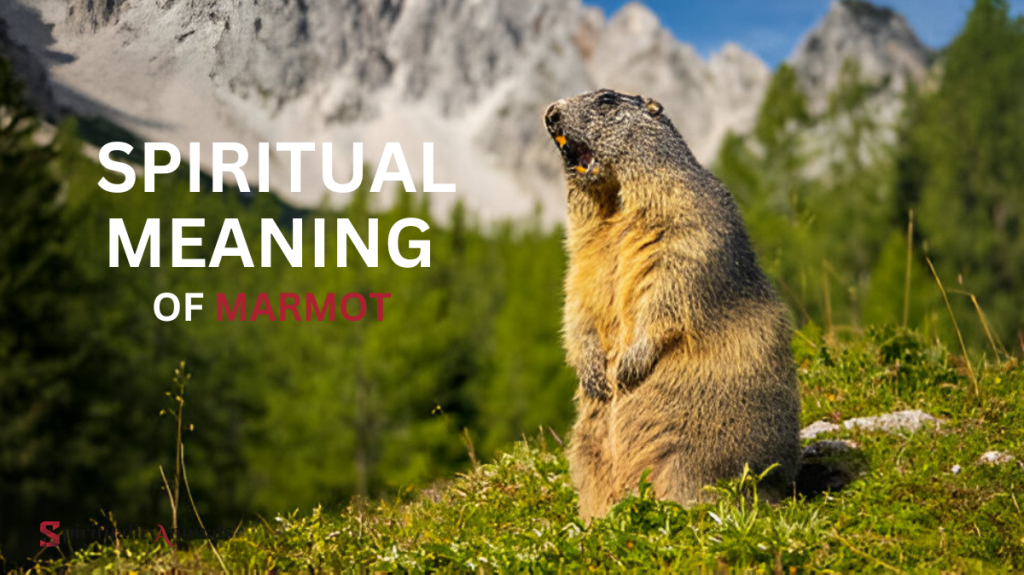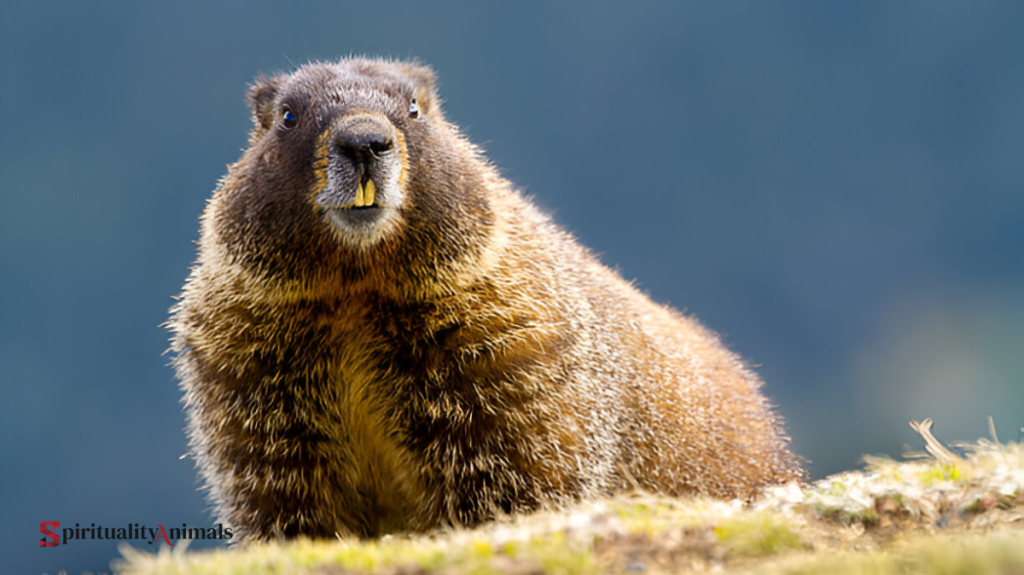Marmots are big fuzzy animals that look like large squirrels. They live in mountains and grassy fields. They dig homes under the ground and sleep all winter long. Many people think marmots are special animals with important meanings.
Just like how a bear might mean strength or an owl might mean wisdom, marmots have their own special meanings too. This story will tell you what marmots can teach us and why people think they are special.

Contents
- 1 Brief Answer on Spiritual Meaning of Marmot
- 2 Overview of Marmot Symbolism
- 3 Importance of Marmot in Spirituality
- 4 Meaning and Messages of Marmot
- 5 Types of Marmot and their Meaning
- 6 Historical Context of Marmots
- 7 Spiritual Signs and Characteristics of the Marmot
- 8 Symbolism of Marmots in Different Cultures
- 9 Positive Traits of Marmots
- 10 Negative Traits of Marmots
- 11 Lessons from Marmots
- 12 Marmot as a Power Animal
- 13 Marmot Symbolism in Christianity
- 14 Marmot as a Totem or Spirit Animal
- 15 Dream Interpretation: Marmots in Dreams
- 16 Marmots in Mythology and Folklore
- 17 Tattoos and Their Meanings: Marmot Tattoo Designs
- 18 Conclusion
- 19 Frequently Asked Questions
Brief Answer on Spiritual Meaning of Marmot
The spiritual meaning of the marmot centers on the importance of introspection and preparedness for new beginnings. As an animal that hibernates, the marmot symbolizes the necessity of looking inward, understanding oneself, and conserving energy for a future awakening.
It represents a period of deep reflection and connection to the earth, followed by an emergence into a new phase of life with renewed purpose and awareness.
Overview of Marmot Symbolism
Marmots do many things that people find special. They live with their families. They get ready for winter by saving food. They know when to be active and when to rest.
In many old stories, marmots stand for being ready, caring about family, knowing about seasons, and being smart about when to hide and when to come out.
People call marmots “whistle pigs” because they make loud whistles to warn their friends about danger. This makes them symbols of talking to others and keeping safe. They can also tell when weather will change, so many think they are wise.
Importance of Marmot in Spirituality
Marmots may not be as famous as eagles or bears in stories, but they are very special to people who live near them. These fuzzy animals teach us about balance, getting ready, and living in tune with nature.
People who lived long ago in North America, Europe, and Asia respected marmots. Since marmots dig deep homes in the ground and know when seasons change, old stories say they teach us how to live in balance with nature.
Meaning and Messages of Marmot
Spiritual Messages Marmots Share
Marmots can teach us many things:
Get ready for hard times: Marmots spend all summer finding food for winter. They teach us to think ahead.
Family is important: Marmots live with their families and help each other. They show us why we need friends and family.
Rest when needed: Marmots sleep all winter when food is hard to find. They show us that sometimes rest is the best choice.
Stay awake and aware: Marmots always watch for danger and warn others. They teach us to pay attention to what’s around us.
Love the earth: By digging homes in the ground, marmots have a close bond with the earth. They remind us to care for nature.
Types of Marmot and their Meaning
Bobak Marmot
Bobak marmots live in grassy fields in Europe and Asia. They make big homes with many tunnels under the ground. They show us how to work together. People who live near them tell stories about how these marmots build big family groups.
Alpine Marmot
Alpine marmots live high up in the mountains of Europe. They are tough and can live where it’s very cold. These marmots huddle together to stay warm. Stories about them talk about helping each other when times are hard.
Yellow-bellied Marmot
These marmots live in western North America. They love to sit on rocks in the sun. They teach us to enjoy simple things like warm sunshine. Stories say they know how to work hard but also have fun.
Olympic Marmot
Olympic marmots only live in one park in Washington state. Because they live in just one small place, they stand for being special and one-of-a-kind. Old stories from that area talk about how these marmots belong to their home.
Himalayan Marmot
These marmots live very high in the Himalaya mountains. They can live where the air is thin and it’s very cold. Stories from Tibet say these marmots know how to live in the hardest places.
Vancouver Island Marmot
This is one of the rarest marmots in the world. Very few are left. They show us how some things in nature are rare and need our help. People are working hard to save these marmots.
Hoary Marmot
Hoary marmots have silver-gray fur that looks like gray hair. In some old stories, they stand for being wise like grandparents. These marmots live in northwest North America.
Historical Context of Marmots
Marmots in Ancient Traditions
People have thought marmots were special for thousands of years. Long ago in the Alps, people used marmot fat as medicine. The word “marmot” comes from old words that sound like the noises marmots make.
Native American tribes told stories about marmots. Some said seeing a marmot meant the weather would soon change.
In Mongolia and Tibet, people thought marmots were earth spirits. Hunters would say special words to show respect before hunting them.
Farmers watched marmots to know about weather. They would say things like “when the marmot sits in the sun early, spring will come soon.”

Spiritual Signs and Characteristics of the Marmot
Key Spiritual Characteristics of Marmots
- Getting ready: Marmots get ready for winter for months, showing they are wise planners.
- Family love: These animals live in close groups and protect each other, showing loyalty.
- Knowing when to rest: Their winter sleep teaches us about the right time to be active and to rest.
- Staying alert: Always watching for danger, marmots remind us to pay attention.
- Talking to others: Their warning whistles show why it’s good to tell others about danger.
- Loving the earth: Digging deep homes shows their bond with the ground and nature.
- Fitting in: Different kinds of marmots live in different places, showing they can adapt.
Symbolism of Marmots in Different Cultures
Marmot Symbolism in Various Cultures
Native Americans in mountain areas saw marmots as healing animals with special knowledge. Some thought marmots could carry messages between our world and the spirit world.
People who lived in the Alps watched marmots to know about weather. They could tell if spring would come early by what the marmots did.
In Mongolia and Tibet, marmots were seen as sacred. Hunters would ask the marmot’s spirit for permission before hunting them.
Today we still see this with Groundhog Day. A groundhog (which is a kind of marmot) is said to predict if spring will come early or late.
Positive Traits of Marmots
Key Positive Traits
- Getting ready: Marmots teach us to plan ahead for hard times.
- Loving family: They show strong bonds with family and work together.
- Being protective: They are always looking out for danger to keep others safe.
- Using what they have: Marmots make the most of summer to gather food.
- Being patient: During their long winter sleep, they wait for better days.
- Talking clearly: Their warning calls show how to let others know about danger.
- Fitting in anywhere: Different marmots can live in many types of places.
- Knowing nature: They can sense when seasons will change.
Negative Traits of Marmots
Key Negative Traits
- Too careful: Sometimes marmots run away too quickly when scared.
- Not sharing space: They can be very strict about their home area.
- Hiding away: Their long winter sleep might seem like hiding from problems.
- Staying close to home: Most marmots don’t go far from their burrows.
- Taking too much: Their busy gathering might seem like taking more than needed.
- Only liking their own kind: Marmots mostly bond with their own family groups.
Lessons from Marmots
Important Lessons from Marmots
- Get ready for hard times: Just as marmots get ready all summer for winter, we should get ready for hard parts of life.
- Love your family: Marmots teach us about the good things that come from close family ties.
- Follow nature’s timing: These animals know just when to be active and when to rest.
- Make a safe home: Marmots work hard to build safe homes, showing why having a safe place matters.
- Talk clearly: Their warning whistles show why it’s good to speak up when there’s danger.
- Live with nature: Marmots time their activities with the seasons, teaching us to work with nature.
- Know when to rest: Their winter sleep teaches that sometimes rest is the best choice.
Marmot as a Power Animal
Power Animal Messages from the Marmot
If you feel a special link to marmots, they might be telling you:
- Get ready for changes: The marmot might be telling you to prepare for what’s coming.
- Make family bonds stronger: This animal often appears when family needs more care.
- Take time to rest: Marmot energy might be saying you need to rest and regain strength.
- Notice warning signs: Just as marmots warn others of danger, you might need to pay attention to warnings.
- Spend time in nature: Marmot as a special animal guide often calls for more outdoor time.
- Balance work and rest: The marmot’s yearly cycle shows the need for both busy times and quiet times.
Marmot Symbolism in Christianity
Christian Interpretations
While the Bible doesn’t talk about marmots, some Christians find meaning in them:
Being wise and ready: Like the wise people in Jesus’s stories who were prepared, marmots get ready for winter.
Caring about community: The marmot’s family life matches Christian teaching about family and helping others.
Taking care of nature: Marmots live in ways that don’t harm their home, showing good care of God’s creation.
New life after winter: Some Christians see the marmot’s winter sleep and spring waking as symbols of new life, like Jesus’s story.

Marmot as a Totem or Spirit Animal
Totem and Spirit Animal Meanings
People who feel a special bond with marmots often:
- Like to plan ahead: They want to be ready for anything that might happen.
- Care deeply about family: Family ties are very important to them.
- Know when to act: They have a good sense of when to move forward and when to wait.
- Speak up about problems: They are good at warning others when something isn’t right.
- Feel close to nature: They often love being outdoors, especially in mountains or fields.
- Understand life’s cycles: They work with the natural flow of busy times and quiet times.
- Make their homes special: Creating a safe, comfy home is important to them.
Dream Interpretation: Marmots in Dreams
Common Marmot Dream Meanings
Seeing a marmot in your dreams might mean:
You need to get ready: The marmot might show up when you need to prepare for something big.
Think about your family: A dream marmot could point to family matters that need care.
Take some rest: Seeing a sleeping marmot might mean you need to rest and take a break.
Pay attention to warnings: A whistling marmot in dreams often means there are signs you should notice.
Connect with nature: Dreaming of marmots in their burrows might mean you need to spend time outdoors.
Changes are coming: Just as marmots know when seasons change, dream marmots might appear before life changes.
Marmots in Mythology and Folklore
Marmot Myths and Folklore
Many cultures tell stories about marmots:
Some Native Americans said the marmot brought fire from the sky to earth, like the hero Prometheus in old Greek stories.
People in the Alps told tales of marmots as humans who changed form and now live under the ground as spirits.
Mongolian stories say marmots came from a great archer, which is why they sit up straight on their back legs to look around.
Groundhog Day, when we watch a groundhog to see if spring will come early, comes from old European stories about marmots.
Tibetan tales describe marmots as messengers who carry dreams between our world and the spirit world.
Tattoos and Their Meanings: Marmot Tattoo Designs
Popular Marmot Tattoo Meanings
People who get marmot tattoos might want to show:
Love of mountains: Many choose marmot pictures to show they love mountain places.
Family ties: A family of marmots might stand for the importance of family.
Being prepared: A marmot gathering food shows getting ready for hard times.
Being protective: A whistling marmot tattoo might mean you watch out for others.
Life’s patterns: A design showing active and sleeping marmots can show life’s natural flow.
Home pride: People from places where marmots live sometimes get these tattoos to show love for their homeland.
Conclusion
Marmots teach us many things by how they live. These fuzzy animals show us how to get ready for hard times, care for family, respect nature’s timing, and make safe homes. Though they may not be as famous as some animals, marmots have special wisdom about living in tune with nature.
Whether in dreams, as special animal guides, or in old stories, marmots remind us to pay attention to the changing seasons of our lives and to get ready for what’s ahead. Their deep homes in the earth remind us to stay connected to nature, while their warning whistles teach us to speak up to protect those we love.
Frequently Asked Questions
What does it mean if I keep seeing marmots in real life?
Seeing marmots often might be a sign to get ready for changes, pay more attention to your family, or notice the seasons changing in your life.
How can I connect with marmot energy?
Spend time outside, especially in mountains or fields. Notice the seasons changing. Make your home cozy and safe.
Are marmots and groundhogs the same thing?
Groundhogs (also called woodchucks) are a type of marmot. All groundhogs are marmots, but not all marmots are groundhogs.
What is the difference between a marmot as a spirit animal and a power animal?
A spirit animal is usually a lifelong guide, while a power animal might come to you for a short time during special times in your life.
Why are marmots linked to weather prediction?
Marmots are good at sensing when seasons change. This led to traditions like Groundhog Day, where we watch to see if the marmot will predict an early spring or longer winter.
Disclaimer: At SpiritualityAnimals, we share spiritual and symbolic interpretations based on traditional wisdom and personal insights. Our content is purely informational and should not replace professional guidance.
